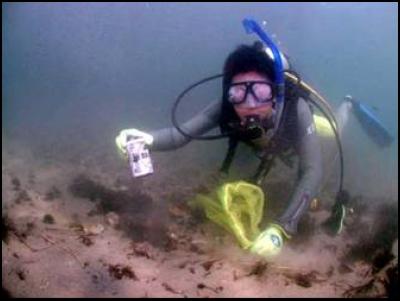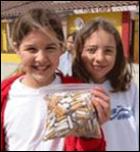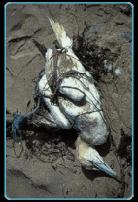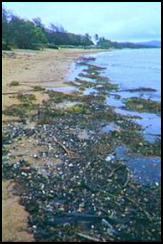Clean Up Our Coast programme nets record amount
October 2006
The Clean Up Our Coast programme
nets record amount of rubbish

What does a car bumper, a syringe, a toothbrush, a cow tag and half a sponge mattress have in common? They have all been cleared away from New Zealand’s coastline through the ‘Clean Up Our Coast’ programme, an environmental initiative of the Sir Peter Blake Trust.
 ‘Clean Up Our Coast’ is celebrating its
two-year anniversary on October 3. The scheme involves
volunteers choosing a coastal region and clearing away the
rubbish, while logging the results. The gathered data are
then analysed by the Trust to determine the type and
location of our coastal debris.
‘Clean Up Our Coast’ is celebrating its
two-year anniversary on October 3. The scheme involves
volunteers choosing a coastal region and clearing away the
rubbish, while logging the results. The gathered data are
then analysed by the Trust to determine the type and
location of our coastal debris.
Sir Peter Blake Trust Executive Director, Dr Mark Orams, believes the initiative is enormously important.
“The ocean is one of the most important environmental assets on our planet. While New Zealand is isolated, we are not disconnected from the rest of the world. If our oceans are poisoned, we are poisoned too.”
He says the initiative does not intend on being just the “ambulance at the bottom of the cliff” but the Trust intends to use the information gathered to educate.
“We are gathering these data so we can shape people’s behaviour and make the general public more responsible with how they handle waste.”
Dr Orams says while many New Zealanders like to perceive our coastline as being pristine and beautiful, figures compiled from ‘Clean Up Our Coast’ indicates otherwise.
“The overall mean is 3.1 pieces of rubbish per 100 square metres, with some areas on the Coromandel Peninsula having as much as 5.8 pieces of rubbish per 100 square metres. Glass, hard plastics and fishing gear make up the majority of debris removed from our coastline.”
The effect of marine debris is wide-ranging and long-term. The impact is more profound than visual pollution, with marine wildlife being affected through ingesting small pieces of debris or being strangled by cast-off fishing nets, says Dr Orams.
“There was a specific experience that brought the problem of marine litter to my attention,” he says. “While I was sailing on the Whitbread Round the World Race with Sir Peter Blake, we came across huge amounts of rubbish floating in the middle of the Atlantic. It was mind-blowing to be in the open ocean and see the significant influence human waste products were having on the sea.”
The majority of the clean-ups are done by crews onboard the Spirit of New Zealand, but other community groups and schools are beginning to take part.
 Mount
Hobson Middle School has joined the programme in a unique
way. They have used the ‘adopt-a-beach’ approach and
regularly clean Cheltenham beach.
Mount
Hobson Middle School has joined the programme in a unique
way. They have used the ‘adopt-a-beach’ approach and
regularly clean Cheltenham beach.
The school’s Academic Manager, Alwyn Poole, believes it is important for the youth of today to respect and cherish the environment.
“The work the Sir Peter Blake Trust is doing on this initiative is fantastic,” says Mr Poole. “They are developing leadership skills in young New Zealanders so our children are equipped with the means to protect our environment for the generations to come.”
With summer just around the corner, the Trust hopes people will take greater care with their rubbish while holidaying at coastal locations. “It is important that people realise that most of the rubbish and debris that ends up in the sea comes from our activities on the land – loose and discarded items end up on the coast via storm-water drains and from wind blowing items into the sea” says Dr Orams.

The Sir Peter Blake Trust wants all Kiwis to play their part in keeping our country not just “clean and green” but to remember we also need to care for our coasts to keep New Zealand “clean, green and blue”.
ENDS


 Plains Media: Plains FM Announces Name Change After 37 Years
Plains Media: Plains FM Announces Name Change After 37 Years NIWA: Flooding From Underneath - New Tool Reveals Shallow Groundwater Elevations
NIWA: Flooding From Underneath - New Tool Reveals Shallow Groundwater Elevations Commerce Commission: Commission Concludes Auckland Airport Over-charging By $190 Million
Commerce Commission: Commission Concludes Auckland Airport Over-charging By $190 Million The Future Is Rail: Ferry Decision - Common Sense Prevails
The Future Is Rail: Ferry Decision - Common Sense Prevails Aotearoa Food Rescue Alliance: Grocery Market Reform Must Include Mandatory Food Rescue Partnerships
Aotearoa Food Rescue Alliance: Grocery Market Reform Must Include Mandatory Food Rescue Partnerships Hugh Grant: Zero Trust Security - A Buzzword Or The Ultimate Protection?
Hugh Grant: Zero Trust Security - A Buzzword Or The Ultimate Protection?



